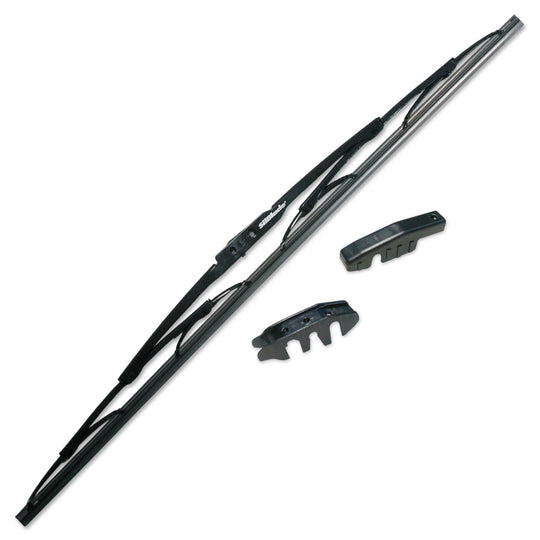The humble rear wiper blade, often neglected until a downpour exposes its ineffectiveness, plays a crucial role in maintaining optimal driving visibility. It ensures a clear view of the road behind you, especially during rain, snow, sleet, or even heavy dust storms. This guide delves into the world of rear wiper blades, exploring their benefits, proper usage, and replacement frequency.

Understanding Rear Wiper Blades: Functionality and Design
Unlike their larger front counterparts, rear wiper blades are typically smaller and have a simpler design. They consist of a rubberized wiping element attached to a metal frame that connects to the wiper arm. The wiping element is crucial, as it makes direct contact with the rear windshield, effectively sweeping away water, dirt, and debris.
Rear wiper blades come in two main types:
- Traditional: These blades feature a metal frame encased in a rubber housing. They are a cost-effective option but may not offer the same level of performance as beam blades.
- Beam Blades: These blades have a more aerodynamic design, with a flexible, spring-loaded metal strip encased within a sleek rubber shell. This design provides more uniform pressure across the windshield, resulting in a cleaner wipe.
The Advantages of a Functioning Rear Wiper Blade
A properly functioning rear wiper blade offers several benefits for safe and confident driving:
- Enhanced Rear Visibility: During rain, snow, or even when driving through a car wash, a rear wiper blade ensures a clear view of the road behind you. This allows you to make informed decisions regarding lane changes, merging, and maintaining a safe following distance.
- Reduced Stressful Driving: Poor rear visibility due to a faulty wiper blade can be a significant source of stress, especially in bad weather conditions. A functioning blade eliminates this concern, allowing you to focus on the road ahead.
- Improved Safety: By providing a clear view of your surroundings, a rear wiper blade helps you react promptly to potential hazards behind you, like sudden braking or swerving vehicles.
- Reduced Glare: Rain streaks and water droplets on the rear windshield can create distracting glare during night driving. A functioning rear wiper blade keeps the rear window clear, minimizing glare and improving nighttime visibility.
- Prevents Damage: A neglected rear wiper blade with worn-out rubber can scratch your rear windshield over time. Regularly replacing the blade keeps the wiping element soft and pliable, preventing unnecessary wear and tear on your car’s glass.
When to Replace Your Rear Wiper Blade
Several factors indicate the need for a rear wiper blade replacement:
- Streaking and Smearing: If your rear wiper blade leaves streaks or smears on the windshield after sweeping, it’s a clear sign that the rubber has worn out and lost its effectiveness.
- Chattering Noise: A chattering noise while the rear wiper is in operation suggests an uneven or damaged wiping element. This can be caused by a warped blade, worn rubber, or debris lodged within the frame.
- Cracked or Brittle Rubber: Over time, exposure to sunlight and extreme temperatures can cause the rubber on the wiper blade to crack or become brittle. This reduces its ability to conform to the curvature of the windshield and effectively remove water.
- Skipping or Lifting: If the wiper blade doesn’t make full contact with the windshield or skips sections altogether, it’s likely bent or damaged. Replacing the blade is the best solution.
As a general guideline, it’s recommended to replace your rear wiper blade every 6-12 months, or sooner if you notice any of the signs mentioned above.
Using Your Rear Wiper Blade Effectively
While seemingly straightforward, using your rear wiper blade effectively can optimize its performance and lifespan:
- Adjust the Wiper Arm Tension: Some wiper arms allow for minor adjustments to the tension with which the blade presses against the windshield. Ensure the blade makes firm but gentle contact for optimal cleaning.
- Clean the Wiper Blade Regularly: Use a damp cloth to wipe away dirt, debris, and road grime that can accumulate on the rubber element. This prevents these elements from scratching the windshield.
- Lift the Blade When Not in Use: During heavy snowfall or when parked for extended periods in extreme temperatures, lift the wiper blade away from the windshield to prevent it from freezing to the glass. This can damage both the blade and the wiper arm.
- Use Winter Wiper Blades: In areas experiencing harsh winters, consider investing in winter wiper blades specifically designed to withstand snow and ice accumulation.
Finding the Perfect Rear Wiper Blade for Your Car
Silblade, a reputable retailer of automotive parts and accessories, offers a wide selection of rear wiper blades to fit various car models.

